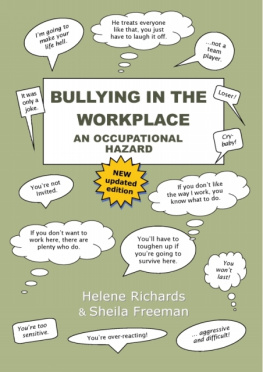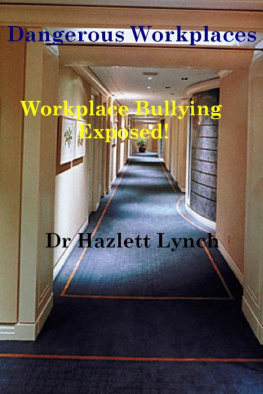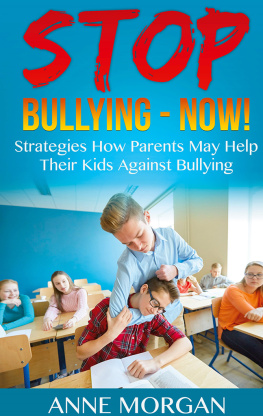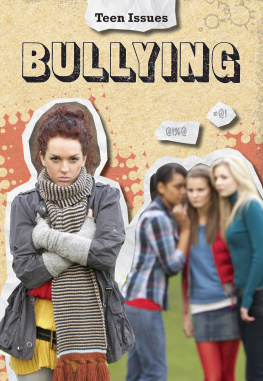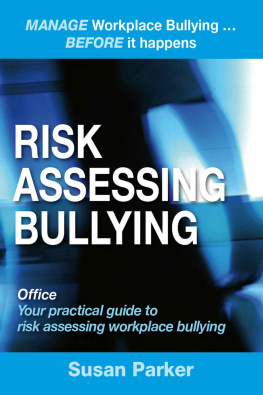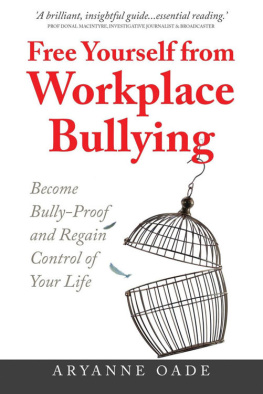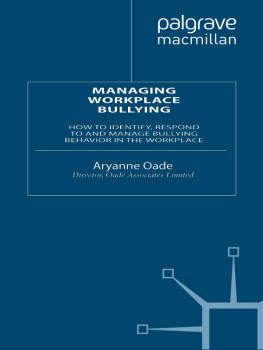
BULLYING IN THE
WORKPLACE:
AN OCCUPATIONAL HAZARD
HELENE RICHARDS
& SHEILA FREEMAN
This book is copyright. Apart from any fair dealing for the purposes of private study, research, criticism or review, as permitted under the Copyright Act, no part may be reproduced, stored in a retrieval system or transmitted in any form or by any means, electronic, mechanical, photocopying, recording or otherwise, without written permission. Enquiries should be directed to the publisher.
First published 2002 by HarperCollins
This edition 2012
Helene Richards & Sheila Freeman 2012
Richards, Helene & Freeman, Sheila
Bullying in the Workplace: An Occupational Hazard
ISBN 978-184982-270-1
ePublished by MP Publishing
MP Publishing 12 Strathallan Crescent Douglas Isle of Man IM2 4NR British Isles
CONTENTS
PART 1
The bully
PART 2
The aftermath
S pecial thanks go to Terry Amey, Julie-Anne Bennett, Judith Cooke, Jim Glaspole, Barbara Gurry, Carl Marsich, Philip Merifield, Stephanie Merifield, Susan Miller, David Morarty, John OReilly, Jane Rylance, Patsy Toop, Jill Wood and Jo-Anna Zappia, and to the many professionals who preferred not to be named but very generously gave us their insights into different aspects of bullying.
We owe a huge debt of gratitude to all those who shared their stories with us, both for the original book and for this new edition, even though it meant reliving a time of great trauma. Most of you did not want to be named and we have respected your wishes.
We thank our husbands, Colin and Jeff, for their unstinting support, encouragement and forbearance, and their willingness to take on additional domestic chores during our rewriting time.
We are grateful to David Williamson and Currency Press for permission to use sections of Davids play Charitable Intent, which looks at workplace tensions in a charitable organisation called Enabling and Caring. The play, a story of victimisation and ruthless personal ambition, focuses on a workplace mediation conference. The characters are:
Jack (the conciliator/facilitator)
Amanda (long-term employee, program manager and primary victim of bullying)
Brian (chair, board of management)
Stella (long-term employee and Amandas only supporter, Stella worked as financial controller until moved to researching for Bryony)
Tamsyn (human resources manager)
Cassie (previously Stellas assistant, Cassie took over Stellas job)
Ciulia (head of public relations and marketing)
Bryony (chief executive officer and the bully).
Disclaimer: Some case studies are taken verbatim from taped interviews, some are condensed versions of stories told to us in interviews, some have been written by the victims themselves, and some are compilations of cases told to us. Because of confidentiality issues, all names have been changed and any identifying information removed.
All Human Beings are born free and equal in dignity and rights... No one should be subjected to arbitrary interference with his privacy, family, correspondence, nor to attacks upon his honour and reputation. Every one has protection of the law against such interference or attacks.
Articles 1 and 12 Universal Declaration of Human Rights 1948
B ullying. For most of us, that word conjures up images of the schoolyard taunts and fist fights, stolen lunches, trashed lockers, groups of girls sniggering and pointing. Many of us have been victims or witnesses of school bullying, and may even have participated in it; we have read shocking stories of apprentices being tortured by older workmates, and military recruits being brutalised.
In theory, times have changed. There is more research and education world-wide about bullying. Schools and workplaces now have policies that attempt to prevent or minimise bullying; children are taught that such behaviour is unacceptable and that, if it does occur, there will be serious consequences for the perpetrators. Hopefully, fines and criminal convictions handed down against employers in cases of workplace violence will deter others from continuing traditional workplace cruelty to young employees.
In reality, there has been little improvement since 2002, when the first edition of this book was published by HarperCollins. Bullying remains widespread and, in fact, advances in technology have caused a massive increase in cyber-bullying, which was in its infancy then. Now perpetrators can be anonymous and malignant messages can be sent to thousands with the touch of a button.
Why is bullying still so prevalent, despite growing awareness? Is it because some school bullies continue their aggressive behaviour into adulthood? In Australia, is it because we accept bullying as part of our culture? For example, it is condoned, and even encouraged, in our adversarial legal and political systems, in stricter parenting styles and in sport (sledging, verbal abuse, stand-over tactics, behind the play attacks). On our roads, drivers of trucks, vans and large cars tailgate aggressively because they perceive themselves as having more power. The bullying style of some media personalities and programs is even considered entertainment, as in the aggressive responses of certain talk-back radio hosts to callers, and the pugnacious nature of some reality-TV game shows, where children, adults, couples, families, friends or celebrities battle for a prize in a cut-throat atmosphere that brings out a vicious competitiveness.
An increased media focus on bullying in Australian workplaces and schools means that it has become an open issue for governments, trade unions and employers. Since writing the first edition, we have been employed as workplace trainers, during which we ask attendees to complete forms asking about the incidence of bullying in their workplaces. In many cases, once bullying is identified, the response of the employers is to protect themselves and cover it up. Though they may have a policy in place and have ongoing education and training, they dont want to know a bully is at work in their organisation because it will make them liable for litigation and insurance payments. Despite much research on the topic, it is difficult to estimate with any exactness the levels of workplace bullying, but some recent findings are:
In some 2004 Australian research, around 70 percent of workers reported being exposed to bullying.
In a Times Higher Education Supplement bullying survey in 2005, 77 percent of respondents stated that they had been bullied (rising to 79 percent after participants had identified what bullying meant to them). Seventy-two (72) percent stated that someone was currently being bullied in their workplace.
UK statistics published in 2007 show that 25 percent of people have been bullied at some point in their working lives, with some research indicating that this may be as high as 50 percent.
A 2009 survey of Australian workplaces by Drake International revealed that more than 50 percent of respondents had witnessed bullying and over 25 percent had been targets of bullying.
What the statistics dont show is the catastrophic effect of bullying on its victims. A hostile work environment can lead to depression, prolonged duress stress disorder (PDSD), mental and/or physical breakdown, financial problems, marital conflict, divorce and suicide. Lets face it, many people spend more time at work than they do at home and their families get the time left over from their working day. When the victims employment is terminated, either voluntarily or involuntarily, as a result of bullying, the job loss is an additional trauma, especially for those people who equate themselves with their jobs. Losing such a major part of their lives cuts to the core, leaving behind scars that, in most cases, are as raw many years later as they were when the job loss occurred, and which never quite heal. Sadly, victims are often not believed and receive little support from colleagues and employers, with their distress attributed to a lack in themselves rather than a problem within the workplace. Survivors of bullying recall the insidious erosion of their self-esteem, their confidence in their abilities, and their belief that the good guy wins in the end.
Next page
